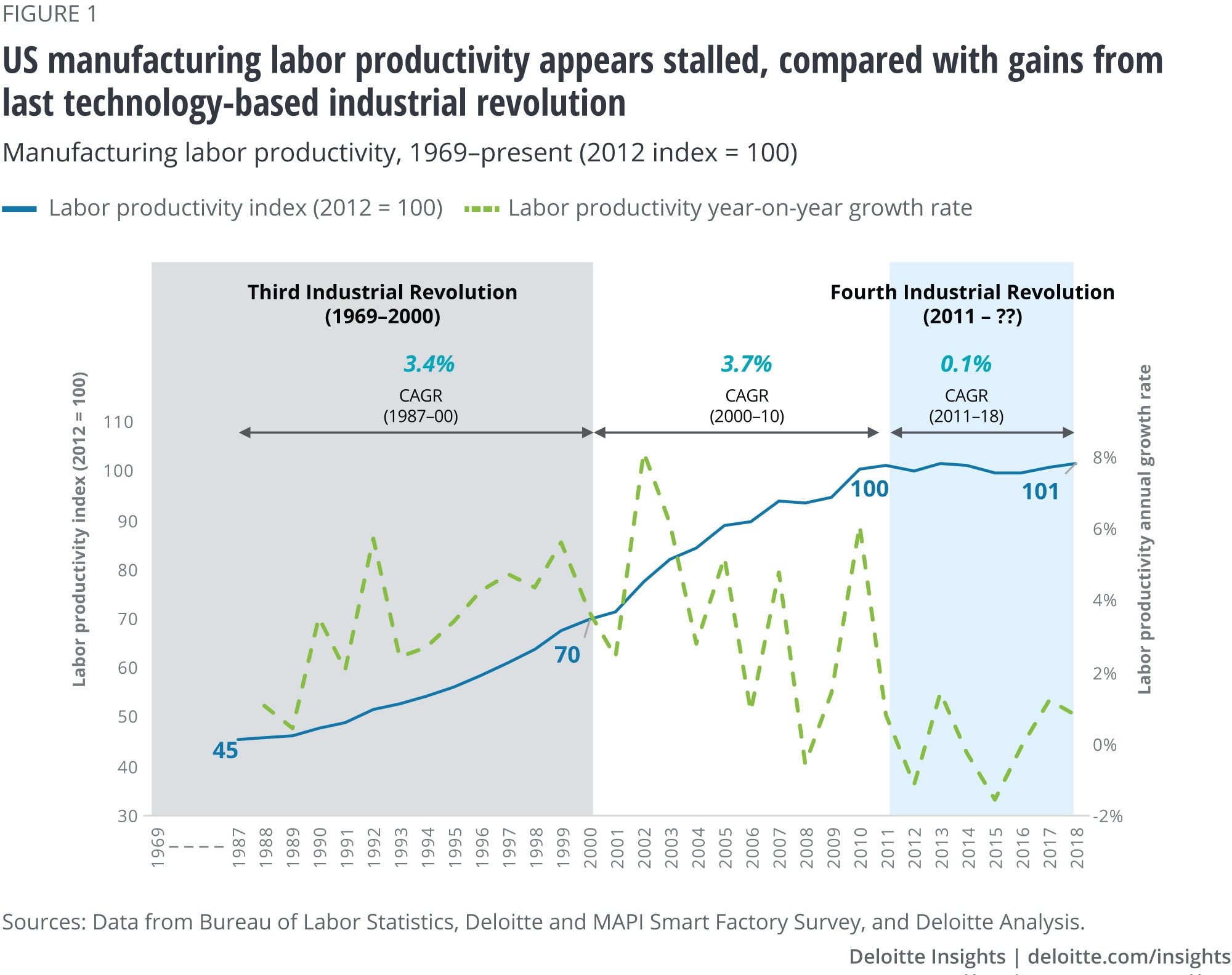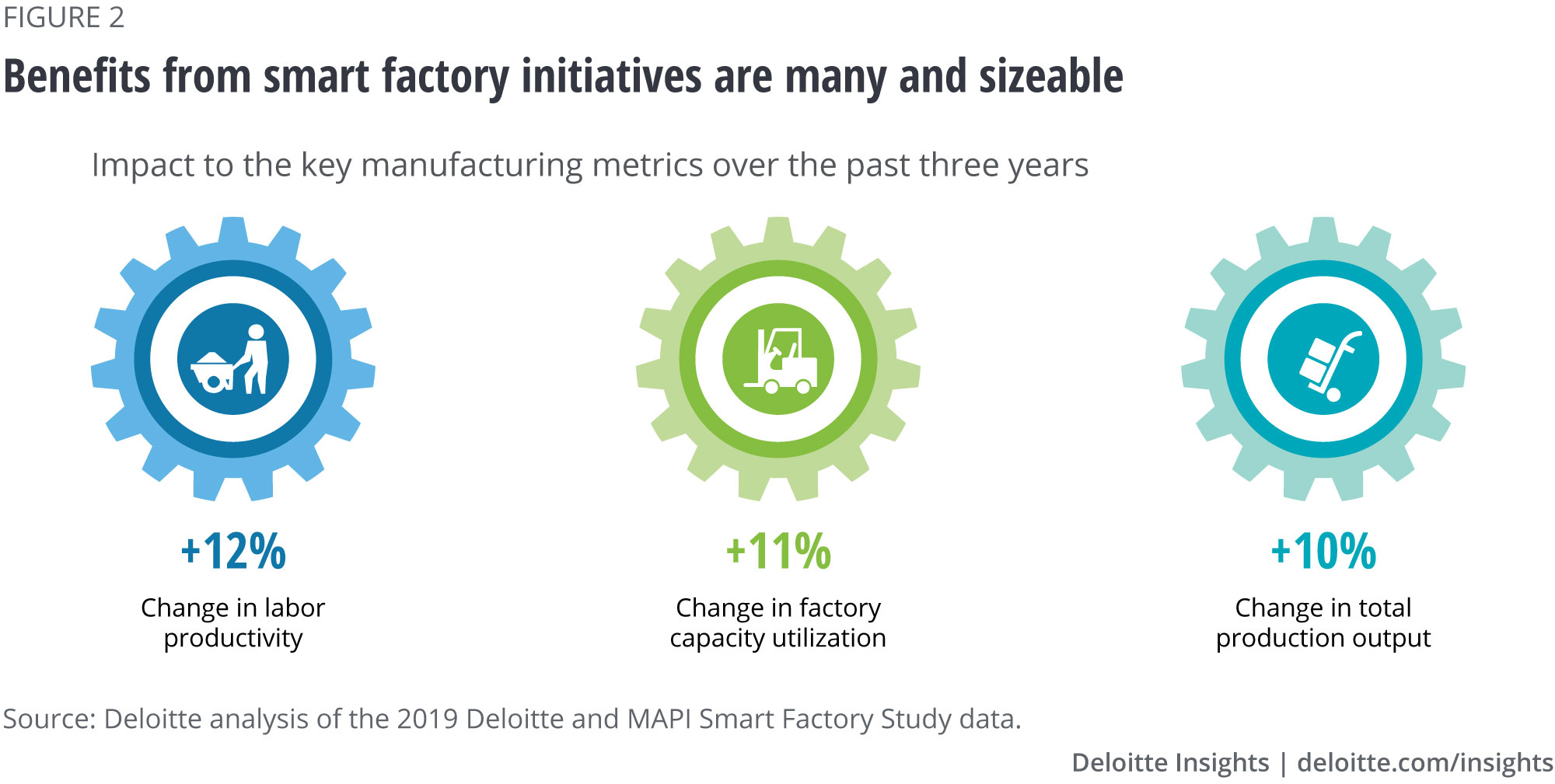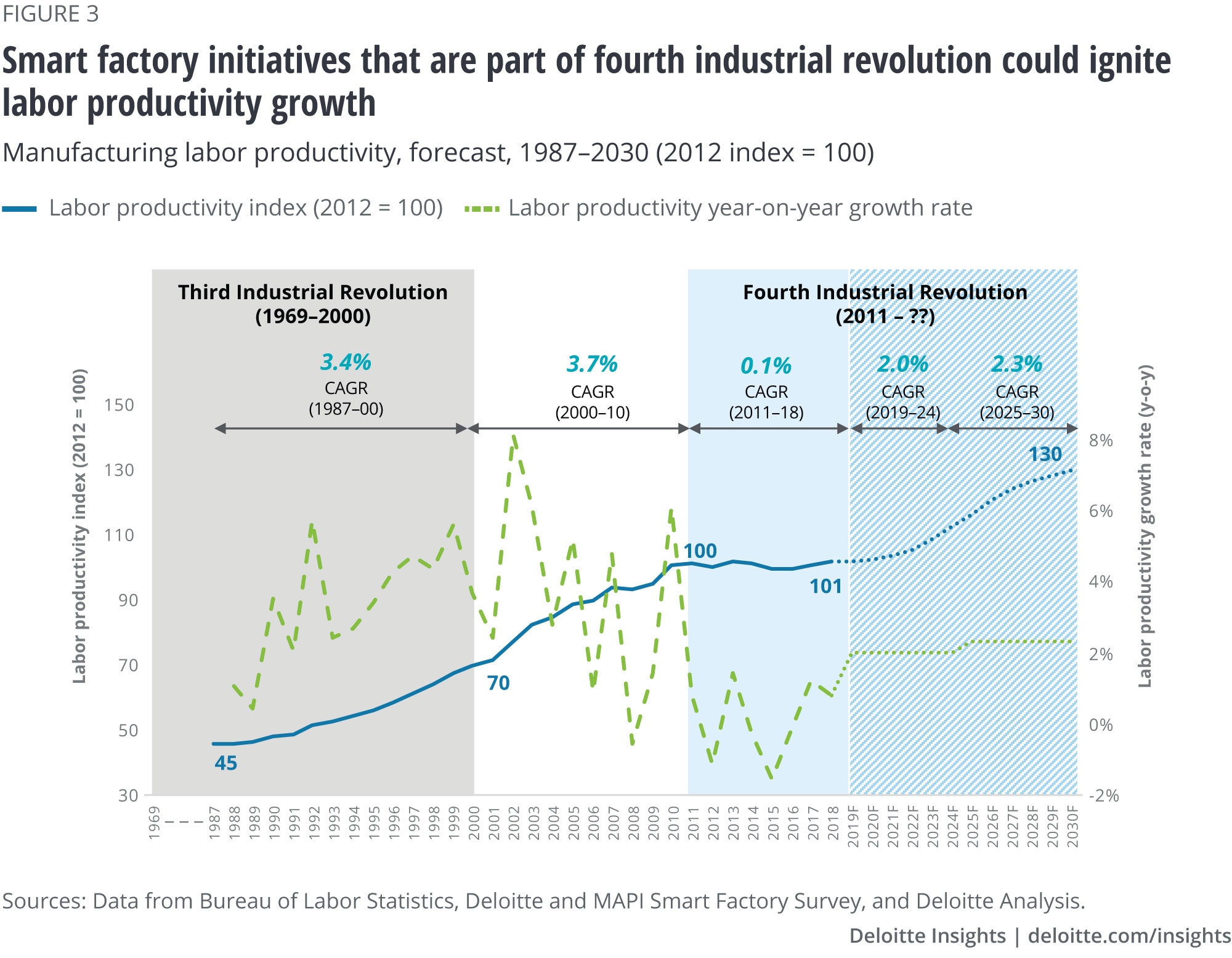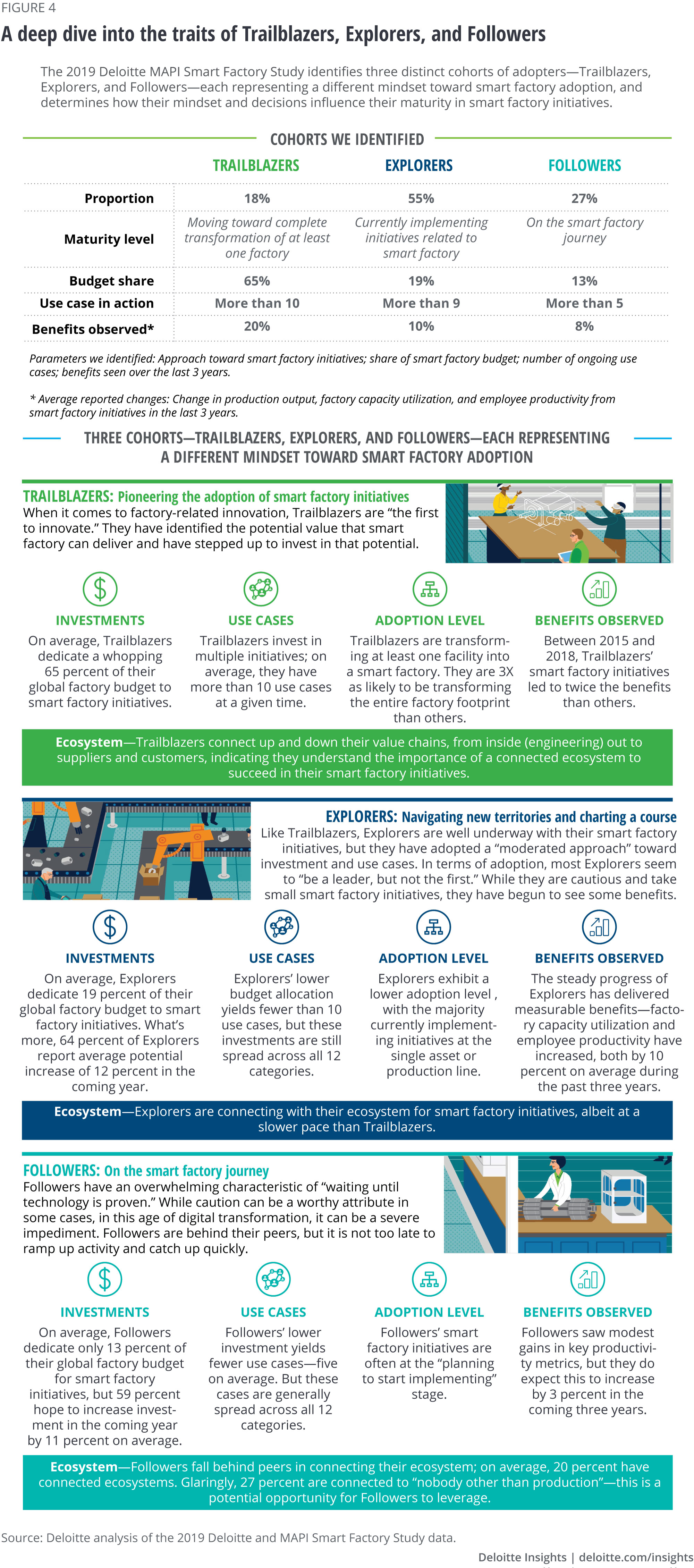
Manufacturing goes digital: Smart factories have the potential to spark labor productivity 2019 Deloitte and MAPI Smart Factory Study
5 minute read
16 September 2019
Smart factories will be the game changer for the US manufacturing industry. Adopting smart factories will likely result in threefold productivity improvements over the next decade.
Each industrial revolution has transformed production, delivered better economic output, and, consequently, immense economic gains globally. But something has shifted in the past two decades—manufacturing productivity growth appears stuck. In spite of the continual improvements in equipment, software, and management approaches, the annual labor productivity growth rate in the United States was around 0.7 percent in the years between 2007 and 2018, and showed zero net average growth during the past five years.
Labor productivity is a major metric of economic output, and gains in productivity are important because, on a macro scale, labor productivity determines the standard of living of people, nations, and the world.1 Currently, however, economic output is moving in lockstep with the number of hours people work, rather than rising as it did for much of the last seven decades (figure 1).2

Learn more
Watch our video and explore the benefits of smart factories
View the related persona
This article is featured in Deloitte Review, issue 26
Create a custom PDF or download the issue
Learn about Deloitte’s services
Go straight to smart. Get the Deloitte Insights app
Enter the Fourth Industrial Revolution—the newest chapter in industrial development that promises to ignite stalled labor productivity in manufacturing via connected machines, people, data, and value chains. In that sense, the smart factory could potentially ignite stalled labor productivity and unlock the key to productivity for manufacturers. But how? In April 2019, Deloitte and the Manufacturer’s Alliance for Productivity and Innovation (MAPI) jointly launched a study to determine how manufacturers are pursuing smart factory initiatives to drive business impact (see sidebar, “Research methodology”). Qualitative and quantitative analysis reveals five major findings:
- Every manufacturer—whether already “running smart” or yet to invest in smart factory technologies—can harvest business value from smart factory initiatives.
- Smart factory initiatives accelerate business value creation. Companies report as much as 10–12 percent gains in areas like manufacturing output, factory utilization, and labor productivity after they invested in smart factory initiatives.
- There is a direct and established connection—primarily through investment and use cases—between smart factory initiatives and the business value realized. What’s more, any manufacturer can use this connection.
- While there are risks, primarily operational and financial, they are outnumbered by the smart factory’s value contribution. Also, most risks can be mitigated through rational stakeholder selection, an efficient change management strategy, measurable proof-of-concepts, and incremental investments.
- An identified cohort—we call it Trailblazers—is outperforming with smart factory initiatives.
Early smart factory adopters report average three-year gains of 10 percent for factory output, factory capacity utilization, and labor productivity. Not just that, these companies expect labor productivity to improve another 2 percentage points to 12 percent by 2022 (figure 2).
Research methodology
Deloitte and MAPI jointly launched a study in April 2019 to quantify the impact of smart factories on US manufacturing productivity and manufacturing’s contribution to the US GDP through 2030. The study included an online survey of more than 600 executives at manufacturing companies with headquarters in the United States and a global factory footprint, interviews with more than a dozen executives from manufacturing companies, and focus group discussions with finance and operations leaders at manufacturing companies. Additionally, we analyzed secondary data and used economic projections from Deloitte’s global economic team. To calculate the manufacturing labor productivity index and manufacturing labor productivity growth rate during 2019–2030, we used Oxford Economics’ Global Economic Model, data from the Bureau of Labor Statistics, and responses from the 2019 Deloitte and MAPI Smart Factory Executive Survey (figure 1).
Additionally, we classified the adoption of smart factories into two phases—phase 1 (2019–2024) that will likely experience relatively slower adoption and phase 2 (2025–2030) that will likely experience accelerated adoption. Based on the level of smart factory adoption reported by the respondents, we classified the sample into two segments: Traditional manufacturers (no ongoing smart factory initiatives; 49 percent of the sample) and manufacturers with smart factory initiatives (some form of ongoing smart factory initiatives; 51 percent of the sample).
We have described the research design and methodology in more detail in the main article, 2019 Deloitte and MAPI Smart Factory Study: Capturing value through the digital journey.

A closer look at labor productivity trends indicates that smart factory initiatives will likely enable the US manufacturers to “observe” triple the labor productivity growth rate during the next decade (2019–2030) compared to last decade (2007–2018).
Using the study data and our forecasting model, we determine that labor productivity will likely grow at a compound annual rate of 2.3 percent during 2025–2030, closer to the level last seen in the 1990s (figure 3).

What does this mean for manufacturers?
The promise of improved labor productivity is certainly enticing for manufacturing, as the industry sits in the midst of a labor shortage that is on the brink of becoming a drag on productivity.3 Technology can spur new levels of productivity throughout the factory as companies combine technologies (such as vision systems, harmonic sensors and cobots with cognitive computing, machine learning, and autonomous capabilities). Each industrial revolution has seen this curve. Significant labor productivity gains manifest toward the end of the cycle, reflecting the cumulative impact of reaching a critical mass of technology adoption. The study identified 12 common categories of use cases—each a combination of advanced technologies targeted at specific business and production processes in smart factories—and our analysis reveals that the majority of manufacturers actively investing in smart factory have an average of nine use cases currently in action.
We have identified six most common use cases, and illustrated their application in the context of how Kentucky Pumps and Valves Company, a hypothetical manufacturer of pumps and valves, uses them in its factory operations (see interactive figure).
Trailblazers lead the way
Another key finding of the study is that there are three distinct cohorts of adopters of smart factory initiatives. We call them Trailblazers, Explorers, and Followers (figure 4). Each cohort represents a different approach toward smart factory adoption. Where activity, maturity, and outcomes are concerned, Trailblazers are leading the way. In fact, this group has seen twice the level of gains to labor productivity compared with Explorers and Followers combined. Furthermore, Trailblazers expect increases in labor productivity to continue to accelerate ahead of the average over the next three years. Clearly, Trailblazers have determined the formula for extracting value through investments in smart factory initiatives.

Final thoughts
Whether manufacturers are just starting on their smart factory journey or well along the pathway like Trailblazers, there’s no doubt that smart factory initiatives could have a significant impact on manufacturing productivity. Naturally, there are caveats. There is also a need to launch these initiatives properly to set a team up for success. When and how smart factory use cases are launched can determine their success. In 2019 Deloitte and MAPI Smart Factory Study: Capturing value through the digital journey we offer a deeper dive into some of the best practices for adopting smart factory initiatives, further insights into how Trailblazers are pushing the envelope, and 10 common approaches to smart factory adoption that can be part of manufacturers’ “playbook” for getting started.
Read the full report, 2019 Deloitte and MAPI Smart Factory Study: Capturing value through the digital journey, for more.
Explore more
-
Smart government Article5 years ago
-
Renewables (em)power smart cities Article6 years ago
-
Global renewable energy trends Article6 years ago
-
The transformation of manufacturing Article11 years ago
-
Geographic trends in manufacturing job creation Article7 years ago
-
The jobs are here, but where are the people? Article6 years ago





















